When I tell you that the arrangement of sweetly colored textural shapes above is not art I sincerely hope you believe it. Admittedly, you have little reason to. You’ve been here before. You’ve seen that week after week I populate this space with images that are in fact art, or could, without too great a leap of imagination, be considered as such. High art, low art, unexpected art, unintentional art; Categorical labels and their attendant quotation marks, though generally eschewed, abound here for those who’d choose to employ them. This post though, is different. Truly. So when I assure you that the image above, and those to follow below are not art, have nothing whatsoever to do with art, and that when looking at them you probably ought to cringe and scowl, your nose ought to wrinkle, and you should turn away feeling vaguely disgusted, know that I mean it.
Contact (i)
Search (i)
Annex (i)
Special Projects (i)
Downloads (i)
Shop (i)
Archives (i)
Links (i)
Feeds: rss2 | atom (i)

This Post is Not About Art


Wit Larded with Malice
Or: The Satirical Russian Magazines of 1905-08
In Russia, following a string of embarrassing defeats in the Russo-Japanese War and the infamous Bloody Sunday incident, during the period of the so called Failed Revolution, no less than 480 underground magazines sprung-up to voice the outrage of the many disparate groups and factions and movements—nihilists, anarchists, socialists, Mensheviks, Bolsheviks, etc—which though unorganized, were united in their calls for Tsarist reform. This outpouring of printed materials, critical of the State, was no small thing in a country with a long history of strict censorship and brutal punishments for dissension. These many short-lived publications are referred to, collectively, as “satires.”
Today, when we (soft, fattened, fiddling Nero’s in miniature that we are) think “satire” we reflexively brace ourselves for the haw-haws. We think of Colbert and the Onion, or if we’re a bit older maybe Weird Al and Doonesbury, or MAD magazine and Dr. Strangelove. If we’re real oldenhiemers, with half a mind left, we might conjure fond memories of The Great Dictator and H.L. Mencken and a childhood of Twain stories and Thomas Nast reprints. In any case, for us, “satire” may as well be a straight-up 1-to-1 synonym for “funny.”
These Russian satires? Not so much.

Granted, I can’t read Cyrillic, and the million little contextual and cultural cues on display are obviously totally beyond me; I’m literally just looking at pictures. But one gets the sense looking over these underground turn-of the-century publications that the “satire” was here accompanied by an entirely different sort of wink. The closest equivalent I can think of, which might resonate for those living in a free and democratic society, would be the evocation of “satire” as a defense in an ugly slander lawsuit… if slander were punishable by death. Not much “comedy” involved. In these Russian magazines “satire” would seem, more than anything, a thin but precious barrier against open reprisal.
It’s said that these satires helped drive public opinion, to bring the criticisms which simmered just below the surface out into the open, and to force the first small concessions from the autocratic Tsar Nicolas II. Whether they in fact shamed the powers-that-be… it’s doubtful. I can say with certainty, however, that the graphic work in these publications, produced as they were under constant threat, does put most “underground” magazine work produced since to shame. The images, bleak and violent, mournful and angry though they are, remain powerful and terrifically beautiful.
Below, as illustration, I’ve reproduced a group of representative images culled from the book Blood & Laughter. Caricatures from the 1905 Revolution, by David King and Cathy Porter, put out in 1983.




Quote: “Bloody Sunday killed superstition, the old faith in a just Tsar, and unleashed a tumultuous rage among the masses… A huge wave of strikes swept the country, paralysing more than 100 towns and drawing in a million men and women. Throughout the summer peasants rioted while terrorists struck at figures of authority.
Alongside the struggle in street and factory was the struggle for the free press. Ministers and clerics suffered assassination more by the pen than the bullet as the revolution strove for the expression of powerful emotions long suppressed. A flood of satirical journals poured from the presses, honouring the dead and vilifying the mighty. Drawings of frenzied immediacy and extraordinary technical virtuosity were combined with prose and verse written in a popular underground language, veiled in allegory, metaphor and references to the past.”



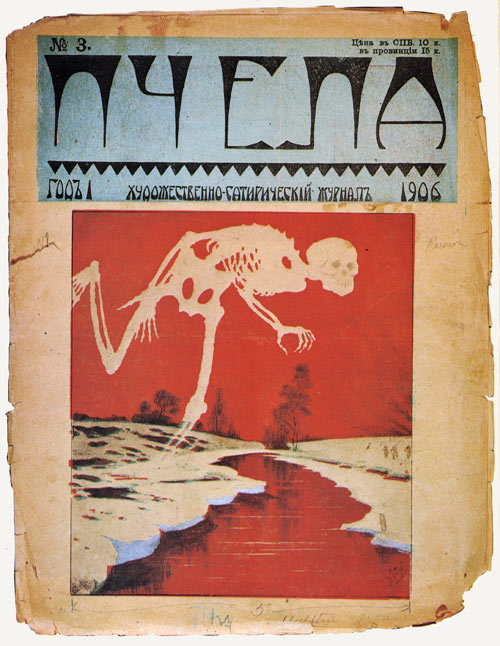
“Russia had a rich history of satirical journalism. In the 1770s, in the reign of Katherine the Great, an elite of intellectuals close to the court developed a new ‘aesopian’ language — deeply subversive to the enlightened autocracy — to express their opposition to the old regime. The satire of the court flourished until the shadow of revolution in Europe drove the Empress to suppress it. Again in the 1860s highly popular satirical journals sprang up, drawing consciously on their courtly predecessors to curse the Crimean War and Tsar Alexander ll’s empty promises of reform. While populist revolutionaries went ‘to the people’ to make common cause with the peasants, radical journalists set out to collect folk-stories, popular sayings, soldiers’ songs and workers’ ballads. The old allegorical vocabulary was joined to the language of popular satire. By the 1870s these journals had been closed down, but this language was now part of everyday speech. Satirical writing returned to the underground, where it flourished, rooted in popular protest, until 1905. It was then that satire achieved its full power.”
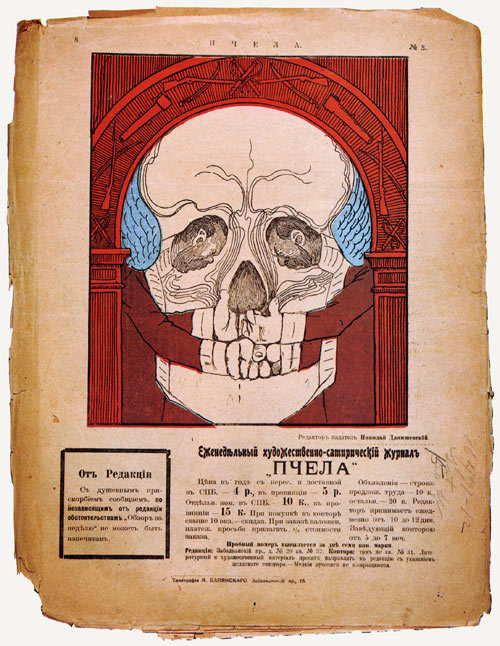



“Satire turned holy names into household names, it insulted authority and withered reputations. Yet although the journals enjoyed an almost fanatical popularity, most writers clung to the anonymity of the underground where, apart from a few who became well-known after the Bolshevik revolution, they tended to remain. The artists proclaimed their names more openly, and a number of them — like Isaac Brodsky, Alexander Lyubimov, Nikolai Shestopalov, Pyotr Dobrynin and Boris Kustodiev — went on to become prominent soviet painters. They and many other artists had all been students in the master-class of the great realist painter llya Repin. In February 1905 Repin and his students had marched together in a demonstration against the Bloody Sunday massacre, and from then on they had all turned to paintings of street demonstrations, meetings and peasant uprisings.”

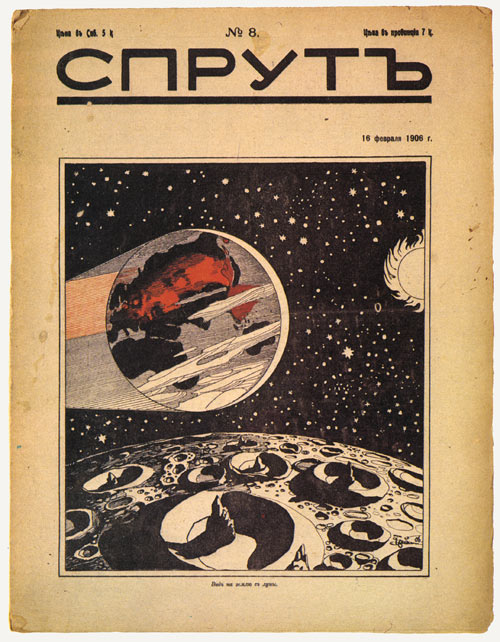
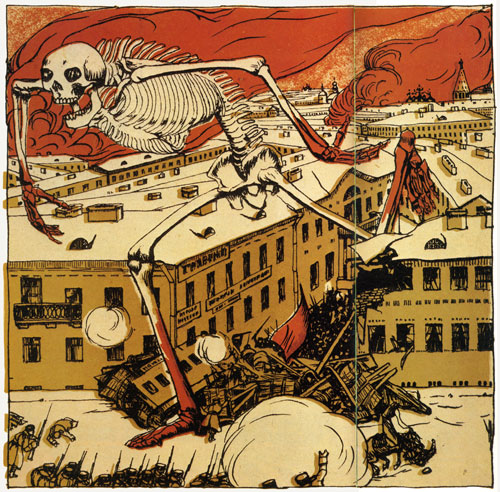
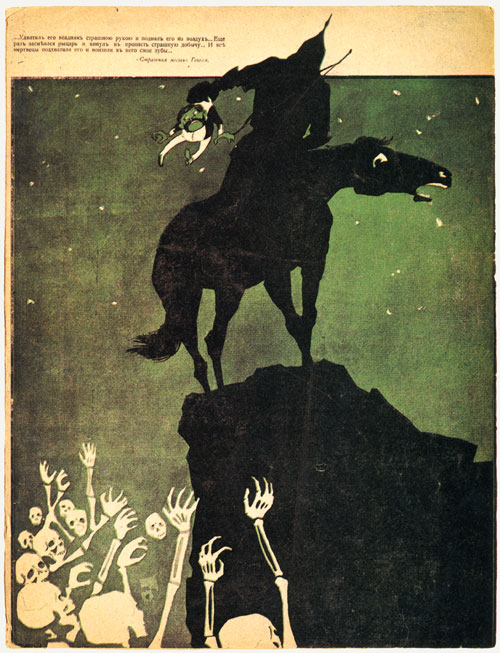
“For a few brief months the journals spoke with a great and unprecedented rage that neither arrest nor exile could silence. At first their approach was oblique, their allusions veiled, and they often fell victim to the censor’s pencil. But people had suffered censorship for too long.Satirists constantly expanded their territory and their targets of attack, demolishing one obstacle after another as they went, thriving on censorship. The workers’ movement grew in boldness, culminating in the birth of the St Petersburg Soviet of Workers’ Deputies, the people’s government. For fifty days the Tsar and his ministers were confronted by another power, another law. Journalists and printers seized the right to publish without submitting to the censor. The satirical journals then reached their apotheosis, until the revolution died as it had risen, bathed in blood.” -Cathy Porter, from her introduction to Blood & Laughter ,1983.
Well…
Apparently slaughter and hunger and class-struggle and brutal autocratic oppression aren’t very amusing when you get right down to it. On the other hand, perhaps for their intended audience these were amusing. Perhaps the simple but revolutionary act of speaking out against an oppressor was powerful enough to make even of a pile of human skulls feel exuberantly therapeutic. As a westerner, living a century later, totally removed from the language and culture and context I can’t rightly say. I mean, Russian humor has always had a slightly darker more grim cast than that of the West hasn’t it? Perhaps these “satires” offer a tiny clue as to why that might be.
If you’d like to see more of these Russian Satires the Yale University Beinecke Rare Book & Manuscript Library has a very nice group of page scans, including interiors. Simply search for “Russia 1905.” Likewise, for more detailed information the Blood & Laughter. Caricatures from the 1905 Revolution is highly recommended.
Hope you enjoyed.
hide full text

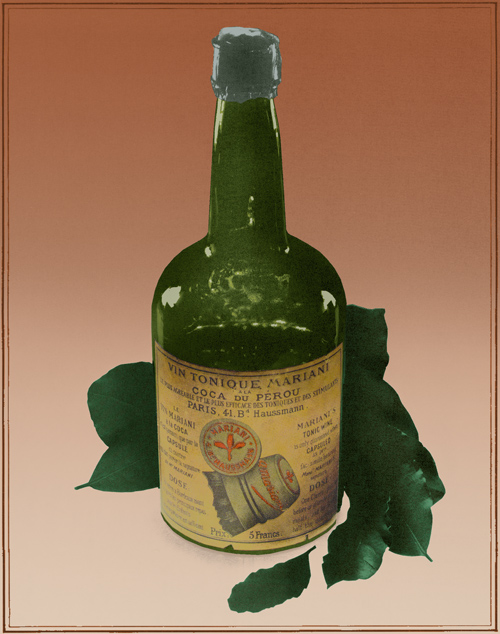
Vin Mariani
“never has anything been so highly or justly praised.”
A good 20 years before the original cocaine-infused Coca-Cola taught the world to grind its teeth and give ineffectual bathroom-stall handjobs in per•fect har•mo•ny, there was another drink of choice among those wishing to feel invigorated and overconfident for no good reason. It was called “coca wine” and it was loved not only by self-important blowhards wearing too much jewelry but by Kings and Popes and… oh, right. Anyhow, it was called Vin Tonique Mariani (or simply Vin Mariani) was sold as a curative, and in the latter half of the 19th century it was a medicinal, recreational, and marketing powerhouse. To paraphrase J.J. Cale “Czars don’t lie, Popes don’t lie, Queens don’t lie…”
In 1863, after having read a paper by Paolo Mantegazza (the man who first isolated cocaine from coca leaves) on the effects of the coca leaf, and seeing the economic potential, Angelo Mariani, a corsican chemist, set to work creating a “tonic” of his own. The resultant coca wine, a Bordeaux treated with coca leaves, was the first recreational cocaine product brought to market. It’s formula evidently yielded a drink which was 10% alcohol and 8.5% cocaine extract by volume.
Typical table wine, today, has an alcohol content of approximately 8-14%, so Vin Mariani falls squarely in the average. Not a fortified rotgut or anything. As for the 8.5% cocaine extract… I don’t really know how to compare that number. It’s more than the 7% Holmes liked to shoot? It doesn’t matter much, however, because evidently it wasn’t specifically the alcohol or the cocaine percentages which made Vin Mariani so potent, but rather the chemical combination of the two.
Quote: “If cocaine is consumed on its own, it yields two principal metabolites, ecgonine methyl ester and benzoyleconine. Neither compound has any discernible psychoactive effect. Cocaine co-administered with alcohol, however, yields a potent psychoactive metabolite, cocaethylene. Cocaethylene is very rewarding agent in its own right. Cocaethylene is formed in the liver by the replacement of the methyl ester of cocaine by the ethyl ester. It blocks the dopamine transporter and induces euphoria. Hence coca wine drinkers are effectively consuming three reinforcing drugs rather than one.” -Cocaine.org

Needless to say this tonic was a hit. So much so that Angelo began using its popularity among “notable personages” as a main selling point. His advertisements still extolled the curative virtues of the product, “renewing, invigorating, nourishing, strengthening, refreshing,” etc…




But damn near every product of the time made similar claims didn’t they? What made Vin Mariani really stand out (aside from the addictive narcotic high, obviously) was Angelo’s celebrity media blitz, a positively banal tactic in todays advertising landscape but, in the 1860’s, almost certainly the first marketing campaign of its kind.
Quote: “Mariani introduced his coca wine in the mid-1860s. By the mid-1880s he was the largest importer of coca leaves in Europe, and his Vin Mariani the most avidly endorsed tonic on both sides of the Atlantic. Testimonials from eminent personages were so numerous that Mariani, as great a public relations man as he was a chemist, published them in handsome leather-bound volumes—replete with portraits and biographical sketches of the endorsers.


Those present included the Prince of Wales, the czar and czarina of Russia, the kings of Norway and Sweden, the commanding general of the British Army, and Pope Leo XIII, who, after many years of sipping Vin Mariani, cited Mariani as a “benefactor of humanity” and presented him with a gold medal.



Some 8,000 doctors swore to the virtues of Vin Mariani. And Dr. J. Leonard Corning of New York, the first surgeon to use cocaine for spinal anesthesia, testified that ‘Of all the tonic preparations ever introduced to the notice of the profession, this is undoubtedly the most potent for good in the treatment of exhaustive and irritative conditions of the central nervous system.’
Alexandre Dumas, Jules Verne, Emile Zola, Henrik Ibsen, and other renowned authors were equally lavish in their praise of Vin Mariani. Bartholdi, sculptor of the Statue of Liberty, wrote that this ‘precious wine will give me the strength to carry out certain other projects already formed.’



Thomas Edison, a man who slept only four hours a day, was a steady user. The secretary of President McKinley noted that a case of Vin Mariani had received an enthusiastic reception by the president. The physicians of Ulysses S. Grant wrote that Mariani products had given the sick general and former president the strength to work several hours a day on his memoirs. And Queen Victoria was so pleased to receive a set of Mariani testimonial volumes that she wrote the master that she considered them among the finest specimens in her collection.” -High Times Encyclopedia of Recreational Drugs, 1978.


The success of Mariani’s wine inspired many imitators, the most famous being, of course, John Smyth Pemberton who’s “Pemberton’s French Wine Coca” would survive various American prohibition laws, the 1906 Pure Food and Drug Act, and growing public anxiety over the addictive qualities of cocaine to become Coca-Cola. Vin Mariani was not as fortunate.
Today, barring some homemade preparation by intrepid psychonauts, the closest you’re likely to get to that original “renewing, invigorating, nourishing, strengthening, refreshing” Mariani high would be through the Peruvian grown, Vin Mariani branded, “coca wine” being produced by the UK company, Mariani Amalgamated, Ltd., and one would have to assume that’s not very close at all. As for the over-the-top celebrity marketing campaigns and the doctor-prescribed highs… hey, no problemo man, we’re cool.
Hope you enjoyed.
hide full text

Occult Chemistry
In 6th century BCE the concept that matter is composed of discrete and not infinitely reducible units developed in India. Around 460 B.C. the Greek Democritus named these fundamental and irreducible bits of matter átomos, meaning “uncuttable.” Notions of this kind were at this point in history, more than anything, matters of pure Philosophy. As such, when the big daddy Aristotle weighed in and rejected the idea as worthless, “the atom” was pretty much stopped in its tracks. It would be a couple thousand years before Science picked up where Philosophy had left off. But before Science made its first excited indirect observations of electrons and protons and managed to put forward a widely acceptable model for the structure of the atom, another group stepped forward to ply their trade in the service of atomic knowledge. They were theosophists, known collectively as the Occult Chemists, and their goal was nothing less than “direct observation of atoms through clairvoyance.”
In 1878 one Dr. Edwin D. Babbitt, proponent of “chroma therapy,” (and granddad of the current duck’s nest of “color therapy”) created for his book Principles of Light and Color and Religion As Revealed by the Material and Spiritual Universe a visualization of the atom which, lunatic and fictional though it may be, is, I must admit, pretty stunning.
See below.

A wild concoction of spirals and vortexes which ties up Babbit’s arguments on bonding, heat, electricity, light, color, friction, and psychic power all in a single unmistakably heart-shaped package. Love it. As it happens the Occult Chemists did not.
Charles Webster Leadbeater, Mrs. Annie Besant, and Curuppumullage Jinarajadasa, the Occult Chemists, having seen the atom first hand through clairvoyance as early as 1895, felt assured in commenting:
Quote: “The illustrations there given of atomic combination are entirely wrong and misleading, but if the stovepipe run through the centre of the single atom be removed, the picture may be taken as correct, and will give some idea of the complexity of this fundamental unit of the physical universe.” -Mrs. Besant, 1909.
They called their vastly different fundamental particle the Anu, which they revealed in the 1909 publication titled, Occult Chemistry, a series of Clairvoyant Observations on the Chemical Elements. The Anu looked like this-

Hmmmmmm. Ahem.
Though ye of the untrained (third) eye might want to yell out, “Hey! that looks, like, exactly the same!” rest assured it is totally different.
Anyhow, this Anu was only the tip of the iceberg as the group went on the describe and visualize a plethora of elements, delving into the structures and relationships in gloriously delusional detail. They were not mere reporters either, their investigations yielded information on matter hitherto unknown! For instance, the element they observed, having an atomic weight of 3 and taking a place on the periodic table between Hydrogen and Helium, which they named… wait for it… Occultum.
Indeed these were the trailblazers of second-sight microscopy.
Below, for your educational edification and viewing pleasure I’ve reproduced a sampling of their findings. Keep in mind when perusing these, however, that…
Quote: “It is, of course, impossible to convey by words the clear conceptions that are gained by direct vision of the objects of study, and the accompanying diagram—cleverly drawn from the description given by the investigators—is offered as a substitute, however poor, for the lacking vision of the readers.” -Mrs. Besant, 1909.
We poor bastards lacking in vision will just have to suffice I suppose.

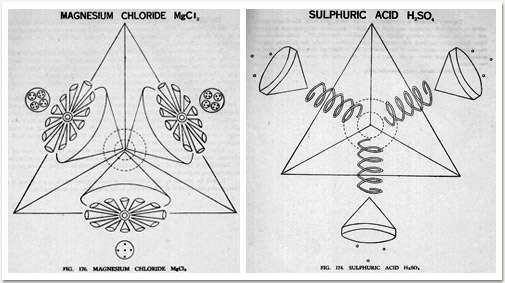








So? Do you believe them? I don’t think they much expected you to. Being occult scientists they were fully aware of the importance of repeatability and in as much leave the corroboration to you.
Quote: “The method of examination employed was that of clairvoyance; there were only two observers - Mr. Leadbeater and myself - and it is very desirable that our results should be tested by others who can use the same extension of physical sight. The researches being carried on upon the physical plane - the forms examined being gaseous and etheric only - a very slight intensification of ordinary vision is all that is necessary, and many should, therefore, be able to test our observations. They cannot be regarded as established, by the outside world, until others have corroborated them; and we put them forward in the hope of stimulating work along this line, and of thus bringing to science, when its instruments fail it, the old, old instrument of enlarged human vision.” -Mrs. Besant, 1909.
Yes indeed. Better get to work ay?
-
I ought to say that initially I intended to do a lengthy write-up on this subject and its protagonists, but as tends to be the case when attempting to delve into the more arcane founts of knowledge, after about 20 minutes the whole mess just starts reading like brain-sapping gobbledygook. So I hope you feel satisfied with this illustrated, albiet very shallow, surface scratching. Anyone brave, brain damaged, or patient enough can of course delve deeper on their own.
For many more images, some context, and much more specific information see the following:
Serious Scientific Lessons from Direct Observation of Atoms through Clairvoyance by J. Michael McBride, Yale University.
Occult CHemistry, Investigations by Clairvoyant Magnification into the Structure of the Atoms of the Periodic Table and Some Compounds by C. W. Leadbeater & Annie Besant.
Occult Chemistry by Anad Gholap.
Religion as Revealed by the Material and Spiritual Universe By Edwin Dwight Babbitt.
Information on the 7 dimensions, the Anu, John Keely, atomic and subatomic particles!
Subtle Energy and Energy Medicine: New Paradigms, New Technologies, New Possibilities
What does an atom look like?, from Hydrogenlab.de
Until next time.
hide full text

The Recumbent Supper
If I accosted you on the street, grabbed you by the shoulders, and blurted, “The Last Supper!” involuntarily (and to spite your fear of being pawed and shouted at by a lunatic) an image would form in your head. We all know what that image is without any need of my describing it because its roughly the same image we all conjure up. It would seem that Western depictions of the last supper, most notably Leonardo Da Vinci’s incredibly iconic version, have dominated the popular imagination in regard to this biblical event to such a degree that we’ve been left with an unshakeable mental image. As it happens, however, it’s an image which deviates considerably not only from scriptural description but from historical reality.
In his 1980 book Now I Lay Me Down to Eat, Notes and Footnotes on the Lost Art of Living writer, architect, collector, teacher, designer, and social historian Bernard Rudofsky used this misconception as a jumping off point to examine western attitudes toward everything from eating to sleeping to sitting to bathing to crapping. It’s a terrific book which, like many of his books, served as an accompaniment to a museum exhibition exploring the same subjects.
In any case, sticking with the Last Supper, I wanted to share a few paragraphs by Rudolfsky on the subject as it’s an interesting historical wrinkle which I suspect many remain unaware of.
-
“One would think that a people that swears by the Bible would be at least vaguely familiar with some of tlie customs of biblical times. Alas, we are not; devout and impious alike are uninformed about testamentary etiquette. What, for instance, do we know about the seating and eating ceremonial at the Last Supper? No more, to be sure, than the fifty-odd generations of artists who, unacquainted as they were witli ancient usages, concurred in misrepresenting the momentous event. Thanks to them, the picture we have formed of it is a glaring anachronism—the apostles might as well be wearing black tie. The legions of painters and carvers were forever at a loss to interpret such stage directions as Saint John ‘lying close to the breast of Jesus’ (John, 13:23). All their attempts to follow the Scriptures to the letter— that is, to portray a recumbent John among companions stiff as pokers—presented an unsolvable problem. Whatever the extenuating circumstances, their common expedient to depict John napping is nothing short of slander.

A trifling incident in our eyes, it does, however, illustrate our ignorance and ensuing intolerance of all conduct that deviates from our own, and this furnishes the keynote to our musings. If Jesus Christ should want to visit this country, he certainly would have to mend his ways. A repetition of the multiplication of bread might be greeted with hosannas, but a miracle of changing water into wine would land him in jail in the holier of our states. Clearly, we’ve gotten the better of scriptural ethics.
To our way of thinking, lying down to a meal connotes debauch. Yet that was the way to eat in Christ’s time among middle- and upper-class Romans and Jews, just as it was for centuries before and after. A corroboration comes from instructions for Passover service: ‘On drinking the four cups, one leans to the left side, as it was the custom in ancient times among free noblemen wlio used to dine on couches in a leaning position.’ Although endorsed in religious doctrine, such behavior seems absurd to us; the whole concept of palpable conviviality flies in the face of our presumed respectability. And yet, wise men with a flair for good living have been known to disregard popular prejudice. ‘I like to eat and drink in a recumbent position (preferably on a couch)’ wrote Nabokov.
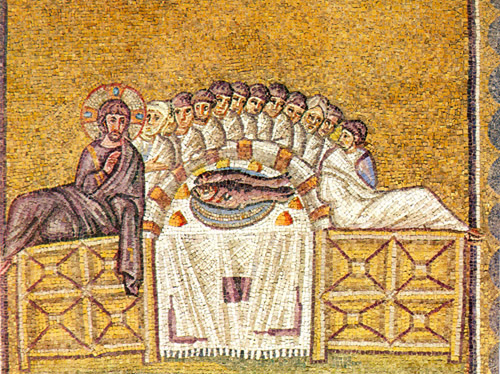
The mosaic (above) shows the recumbent figures on a sigma—a crescent-shaped couch—which, together with the table, forms one single piece. The apostles fit into each other as neatly as stacking chairs—a tangible expression of conviviality. Following the custom of the time, Christ, the host, occupies the place of honor, at the extreme left.
Little of this fraternal closed circuit remains in the Westernized Last Supper. Body contact has given way to discreet stand-offishness; invisible place cards have spread a chill through the proceedings. So has the inexorable grip of symmetry. Christ has been assigned a place in the center and, following Western protocol, everybody is sitting upright, except Saint John, who snuggles up to the Savior s bosom. Such seeming lack of self-control calls for closer inspection.
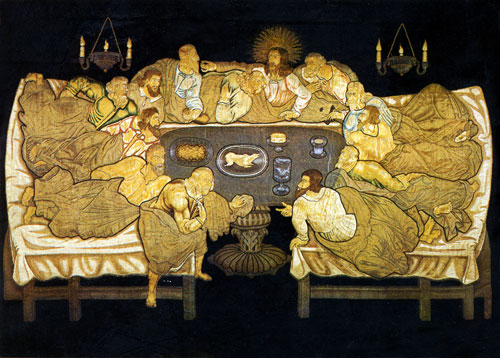
Christian iconography reveals a surprisingly rich repertory of John’s labored poses. He nestles his head in Christ’s palm or in the crook of His arm; hides behind His back; leans on His shoulder; or, most unceremoniously, rests his head right on the table; while Christ, to all appearances, remains oblivious of his beloved disciples difficulties. A New Testament Rip van Winkle, John failed to make the transition from past to present, from East to West. He alone remained faithful to his forefathers’ habits, which his companions, finding them out of place, preferred to ignore. They are portrayed either occupying benches or stools or simply sitting on the floor. A few artists who knew better put them on couches; yet, right down to our time—and this ought to set us thinking—not one presented them sitting on chairs. They all seem to have been aware that there was something very wrong with the looks of a chair.” -Bernard Rudofsky, Now I Lay Me Down To Eat, 1980.
-
Now granted, for many of us the first thought might be something along the lines of, “well, does the historical accuracy of paintings depicting fictional events matter much?” To which I’d have to agree, no, not really. But it’s still interesting.
Hope you enjoyed.
hide full text

The Spectre of Brocken
Soiling Lederhosen Since There Were Lederhosen To Soil
Quote: “On stepping out to the terrace, I was very agreeably surprised to see my shadow some 200 feet high, s thrown on the mist by a strong lamp, rise up to the zenith! It was a very curious spectacle indeed. every movement of the hand or head was faithfully reproduced by the phantasm. But only the head and shoulders of the figure were neatly delineated. The remainder of the body was exceedingly indistinct. Giant rays of colour radiated from the head in all directions.” –E.M. Antoniadai, 1896.
What was for the astronomer Antoniadai “very agreeable” was for generation upon generation before him, understandably, a shock, an anxious source of folkloric speculation, and a bit of a horror.
This 200 foot high shadow figure lurking about the misty mountaintops goes by various names, mountain specter for instance, in China it is called Buddha’s Light, and one would assume that somewhere, at some time, it must be have been called something along the lines of “The Holy Crapuolossus: Bowel Evacuator.” It is best known, however, as the Brockengespenst or Brocken Spectre, owing to the ideal conditions at The Brocken, a peak in the Harz Mountains in northern Germany, for its sudden appearance.

Quote: “A gigantic figure haunts the Mountains, known by the name of “The Spectre of the Brocken.” The ignorant peasants were, in former times, in great fear of it, thinking it a supernatural being, and fancying that it brought upon them all manner of evil. And it must be confessed it was a fearful sight to behold suddenly upon the summit of a lofty mountain an immense giant, sometimes pointing in a threatening attitude to a village below, as if dooming it to destruction; sometimes with arms upraised, as if invoking ruin upon all the country; and sometimes stalking along with such tremendous strides as to make but one step from peak to peak; often dwarfing himself to nothingness, and again stretching up until his head is in the clouds, then disappearing entirely for a moment, only to reappear more formidable than before.” -Frank Richard Stockton, from Round-about Rambles in Lands of Fact and Fancy c. 1910.
De Quincy in his Confessions of an Opium Eater devotes a section to “The Apparition of the Brocken.” If we selectively string together a few sentences (leaving out the far larger chunks about testing the apparition’s faith for fear that centuries of bearing witness to the dark idolatries of pagan sorcerers have made him impure, and the sections about weeping for lost childhood love, like Judea, under a palm-tree) we get this-
“Who and what is he? ...in order to test the nature of this mysterious apparition, we will try two or three experiments upon him… Make the sign of the cross, and observe whether he repeats it. Look! he does repeat it… You are now satisfied that the apparition is but a reflex of yourself.”
Which is, of course, a case of a poet’s hallucinatory metaphor unintentionally touching upon the truth of a thing.

Quote: “A wild tale has long circulated about a giant specter seen by mountain climbers on the Bocken, a German mountain. As the story goes, there was once a climber working his way along the precipice who suddenly saw an immense human figure rise out of the mists toward him. In his fright he lost his footing and fell to his death. Doubtless this is just a story, but the Brocken specter does exist, not only in Brocken but wherever shadows are cast upon mist, fog, and fine water droplets” -Willim R. Corliss, from The Handbook of Unusual Natural Phenomena.
As it happens these specters are in fact the result of multiple, comparatively rare, optical phenomena acting in tandem to produce a sort of “perfect storm” of visual trickery. In truth it’s hard to imagine an illusion more tailor made to give a human onlooker reason for serious pause than a giant, mysterious, mountain dwelling shadow-figure, whose head is surrounded by a luminous nimbus of rainbow-colored light. Perhaps if it also had tits?
I say “comparatively rare” optical phenomena, but of course that’s misleading. This is science we’re talking about here and these phenomena will reliably occur wherever the conditions are right.
From wikipedia: “A Brocken spectre, also called Brocken bow or mountain spectre, is the apparently enormously magnified shadow of an observer, cast upon the upper surfaces of clouds opposite the sun.
The ‘spectre’ appears when the sun shines from behind a climber who is looking down from a ridge or peak into mist. The light projects the climber’s shadow forward through the mist, often in an odd triangular shape due to perspective. The apparent magnification of size of the shadow is an optical illusion that occurs when the observer judges his shadow on relatively nearby clouds to be at the same distance as faraway land objects seen through gaps in the clouds, or when there are no reference points at all by which to judge its size. The shadow also falls on water droplets of varying distances from the eye, confusing depth perception. The ghost can appear to move (sometimes quite suddenly) because of the movement of the cloud layer.
The head of the figure is often surrounded by the glowing halo-like rings of a glory, rings of coloured light that appear directly opposite the sun when sunlight is reflected by a cloud of uniformly-sized water droplets.”
The comparative rarity here is that prior to human flight a comparatively few people actually had occasion to witness this phenomena. In as much you can hardly blame the folks who did for descending the mountain and heading straight for the local Pub to get hammered and spread their tales of giant ghostly figures and high altitude pants crapping.
In any case the illustrations above hardly do justice to the oddity and, yes, beauty, of the Brocken Spectre. As such I’ve gathered together a group of photographs for your viewing pleasure. See below-
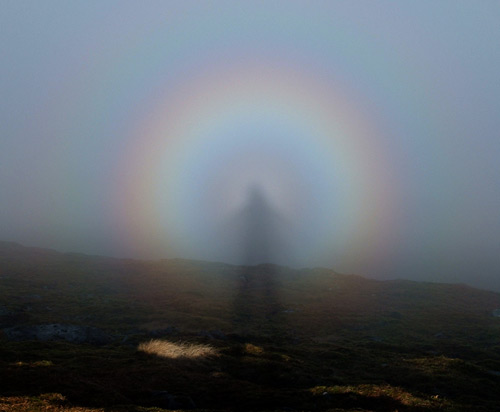









Now that I think about it, I’m not sure a still photo, transmitted over “the tubes,” and viewed on one’s computer screen really does the phenomena justice either. I’m sure under the right circumstances, say pumped full of hallucinogens and trudging alone at dusk on a German mountainside, even we learned moderns might find a landslide accidentally triggered in our lederhosen before our rational minds managed to get the “all’s clear” message out to our jumpy animal parts. Either that or we’d find ourselves not too long afterward telling our bemused mates- “That’s right, I’m quitting my job, changing my name to Baron Fogdancer, and building the worlds largest lollipop factory… Because God appeared to me and told me to! That’s why!”
Anyhow, hope you enjoyed.
For more check out Brocken spectres, bows, and glories by Henry Sharpe.
hide full text
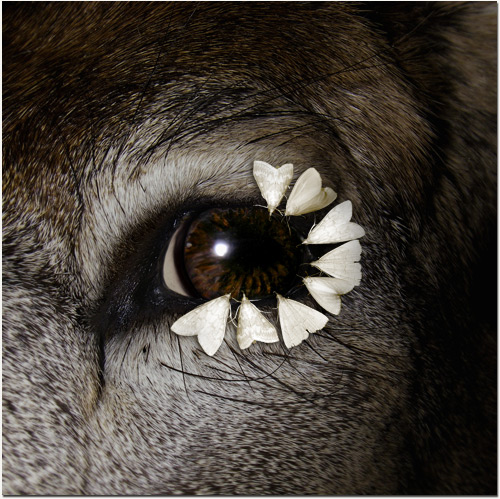
Romancing the Lachryphage
One of the supreme pleasures of that giddy delirium called human consciousness is an unsuppressable proclivity for filtering each extant instant and event, all objects, and every possible thing through the highly sensitive prism of emotion. The result is, put simply, poetry. We look at things around us, purposeful things, functional things, simple, straight forward things, and create out of them, through pattern recognition, anthropomorphism, and analogy a baroque emotional landscape positively rife with the touching, the gut-wrenching, and the glorious. Though the universe does not know it or care, we look around and we shudder at the significance of it all.
What am I rambling on about? Well, how about, for example, lachryphagy?
Can there be a more poetically potent act than that of drinking, and literally drawing sustenance from, another creatures tears?! Drinking tears for christ sake! Really, in human terms, it does not get much more poetically evocative than that, unless of course there is an animal lurking out there in the underbrush who subsists exclusively on the torn-out hearts of pregnant war widows.
For the animals who engage in this behavior, mainly a few species of moth, nothing could be more straight forward. Tears are as good a source of water and salt as any other (not to mention those delicious trace-levels of protein! Yum.) and hell, if no one else is gonna make use of it… Mommy didn’t raise no dummy-larva!

Even so, as a human it would seem nearly impossibly to explain lachryphagy without at least tacitly acknowledging the crazy, unintentional drama the whole undertaking is fraught with from our emotional and symbol-ridden point of view.
Quote: “Some species of moth engage in an almost romantic kissing of the eyes. Mara elephantophila, for example, which drinks the tears of elephants, is among the smallest of such moths. A shy, delicate creature, its tiny size allows it to steal a tear without elephants seemingly noticing.
The highly specialized Lobocraspis griseifusa Does not wait for an animal’s eyes to moisten. When it has landed, it sweeps its proboscis across the eye of its unfortunate host, irritating the eyeball, encouraging it to produce tears. It can even insert its proboscis between the eyelids, ensuring it can feed even while its host is sleeping. Whereas a moth of the genus Poncetia goes to the opposite extreme. It’s proboscis is so short it must cling to the eyeball itself to drink. But it must be careful. If its weeping host blinks, the moth is often crushed to death.” -Matt Walker, from Fish That Fake Orgasms: And Other Zoological Curiosities.
Yes!!!
I literally can’t read that without my brain just shivering in delight.
“Delight?” you ask. Well, yeah, I mean, we’re talking about insects drinking animal tears. As with Love and War, all’s fair in Nature baby, that’s just plain good times. If, on the other hand, moths were dunking those proboscises (who knows where they’ve been!?) and greedily guzzling the wine of human sadness, well…

Quote: “I was observing zoophilous moths in a herd of zebu. One C. ludovicae took tears from a zebu at 1840 h. Shortly afterwards the specimen flew onto my wrist where it sucked perspiration for 10 minutes before it flew onto my naked leg and back onto the front of my head where it continued to take sweat. It flew off and back to my cheek, climbed towards my right eye. finally settling near its lower edge. The perception I now felt was unpleasant and was comparable the that of a particularly edgy grain of sand being rubbed between eye and lid. the source of th epain is revealed in a flash photograph (pictured above) I took 1.5 minutes after the moth settled: the right fore tarsus was hooked onto the delicate conjunctiva of the lid near the eyeball, while the the tear sucking proboscis applied to the eyeball caused less disturbance. Unfortunately the flash scared the moth away which did not return.” - Hans Biinziger, from the paper Remarkable New Cases of Moths Drinking Human Tears In Thailand. (pdf)
No!!!
That moth got away and its tear-fattened progeny are almost surely licking a human eyeball somewhere in Thailand at this very moment! Not to mention these guys…

Yeesh. See, now my brain is shuddering in repulsion, and rather than the sensitive and knowing Emersonian verse which had been growing in the back of my mind, I find poorly written scripts for low-budget horror flicks scrolling across my mind’s eye… Hey! Stay away from my mind’s eye, you damn pesky tear-burglars.
Anyhow, thinking it over, I cant help but get to wondering. Were it not for all the wailing and gnashing of teeth scaring them away, would moths prefer the hormone and painkiller-rich vintage of “psychic tears” (i.e. the type created by stress, suffering, or pain induced weeping) over the run-of-the-mill “reflex’ brand? And for that matter would, say, a toddler’s skinned-knee tears be more or less delicious than a 17 year old’s “we’re both going off to different schools and will want to see other people” tears? Are the tears of a Cubs’ fan in September any good? And what about crocodile tears or the tears of a clown?
Your average elephant or water buffalo doesn’t care much about such things, they just make a loud noise and shake their head about to scare off the moths and then get back to their business, but as I said in the beginning, such is the joy of being a deliriously “aware” human. It is our purview, and ours alone, to get wrapped up in the poetry and metaphorical emotional payload inherent to the survival strategy of an insect, who given the chance, will fly directly into an open flame.
Afterword 1-
The image which began this post, of a deer’s eye surrounded by tear bandits, is a fabrication. I concocted it to resemble a very low resolution image I found showing a similar gathering around a water buffalo’s eye. As much as it pains me to admit it- the deer is stuffed, the eye is glass, and the moths are, well… I don’t know what they are.
How is this even remotely relevant to the discussion at hand you ask? Well, coincidentally (or not), in seeking to create the illustration I found that, for a layman at least, the act of searching out images of specific moths, armed with nothing but the maddeningly complex knot of Latin genus/subgenus/family/sub-family/tribe/ names also happens to induce lacrymation, rather quickly and angrily I might add, and I half expected my face to be swarmed with fluttery little wings terminating in thirsty barbed probosci.
Afterword 2-
In the year 2048, after the fall of western civilization, when an individual’s knowledge and skill-set no longer qualify he or she for well paying jobs but rather automatically initiate them into vicious, roving, cannibalistic street gangs, murderous and vengeful lepidopterologists (and Nabokov scholars) will appropriate the image of the lachryphage, potent and poetic as it is, and use it in the following manner-
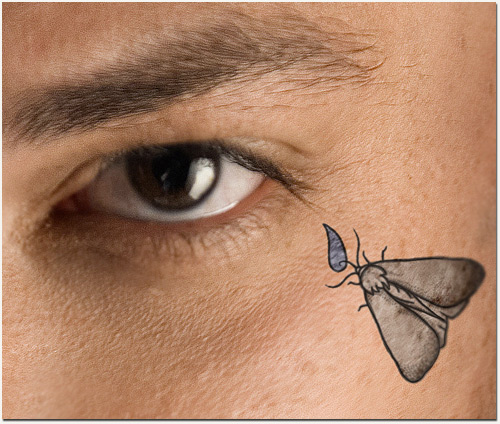
And this tattoo will strike fear into the hearts of their enemies.
Hope you enjoyed.
Related from New Scientist:
Moths with a taste for tears
Moths drink the tears of sleeping birds
Possibly related:
The Jimsonweed Junkies


Some zeitgeist from Independence Days past
The following is a hodgepodge of images and text, taken from The Library of Congress’ American Memory site and the New York Public Library’s Digital Collection, which represent, without much comment on my part, some isolated moments and issues and attitudes from Independence Days past. They span the years between 1844 and 1970 and offer what I hope will be a bit of a gentle counterpoint to our drunken, parade-following, explosion-watching fun today.





-
1898 Reflections Appropriate to “The Fourth”, published in The Century a popular quarterly.
Quote: “The significance of Independence Day this year is greatly enlarged by reason of the war with Spain. The temptation of the Fourth-of-July orator will be to lose sight, in the brilliance of martial events, of the steady white light of national aspiration so clearly reflected in one of the noblest of our patriotic hymns, “America.” This lofty hymn may help to remind us that not in victory alone, certainly not in extension of territory, but in a steadfast dedication to the principles of liberty and justice, lies the true greatness of a nation. The hymn contains no line of boasting or self-glorification, and the contemplation of its pure sentiment will be useful at this time, lest we forget in the allurements of martial success that war is only a means to an honorable peace.”
-





1915 Sheet Music for the song Hurrah for the USA. First verse:
“I love to be in a land that’s free from tumult and war,
Where right is seen to be supreme, that’s what we’re striving for,
So every day let each one pray our friends across the sea,
Lay down their arms and go to their farms and live in harmony,
Hooray Hooray for the good ol’ U S of A.”

1938 From the WPA funded American Folklore Project.
Quote from Miss Nettie Spencer, of Portland Oregon, remembering the Fourth of her childhood:
“It was the big event of the year. Everyone in the countryside got together on that day for the only time in the year. There would be floats in the morning and the one that got the [girls?] eye was the Goddess of Liberty. She was supposed to be the most wholesome and prettiest girl in the countryside — if she wasn’t she had friends who thought she was. But the rest of us weren’t always in agreement on that… Following the float would be the Oregon Agricultural College cadets, and some kind of a band. Sometimes there would be political effigies.
Just before lunch - and we’d always hold lunch up for an hour - some Senator or lawyer would speak. These speeches always had one pattern. First the speaker would challenge England to a fight and berate the King and say that he was a skunk. This was known as twisting the lion’s tail. Then the next theme was that any one could find freedom and liberty on our shores. The speaker would invite those who were heavy laden in other lands to come to us and find peace. The speeches were pretty fiery and by that time the men who drank got into fights and called each other Englishmen. In the afternoon we had what we called the ‘plug uglies’ — funny floats and clowns who took off on the political subjects of the day…The Fourth was the day of the year that really counted then. Christmas wasn’t much; a Church tree or something, but no one twisted the lion’s tail.”




Hope you found these to be interesting or thought provoking or at very the least visually stimulating.
Happy 4th.
hide full text

On The Magic Island
By W.B. Seabrook with illustrations by Alexander King.
In 1929 a travelogue was released that would, through the chain reaction it set off, have a profound effect on American popular culture and by extension the American collective consciousness. It was written by a fellow with a questionable resume of personal traits said to include alcoholism, occultism, sensory deprivation, and sadism, who would ultimately commit suicide by pill-overdose. His is not a household name, and is rarely spoken, yet it is through the continued fascinated invocation of another name altogether that we unknowingly evoke his legacy: Zombie! Zombie!! Zombie!!!
He was William Buehler Seabrook, a reporter and Lost Generation writer (claiming the minor distinction of having written the first celebrity rehab tell-all) and it was his book, The Magic Island, a sensationalized account of his voodoo-mad travels throughout Haiti, that first ushered our beloved un-dead bugaboo, the zombie, onto American shores.
Though The Magic Island did
notrepresent the first usage in English print of the word zombie (it appeared as a term connected to a Voodoo snake god much earlier) as the author later claimed in his autobiography, Seabrook’s book was the first popular English language text to confront the phenomena of the Haitian “living dead” head-on. The book referred to these shambling, dead-eyed, unfortunates as “Zombies” + and they have moved, at varying speeds, among us ever since.
The popularity of his book, with its sensational but not altogether unsympathetic characterizations, dovetailed perfectly with a zeitgeist that would also yield the nearly concurrent release of Hollywood’s iconic monster features. The result of which was an immediate pop-cultural embrace, bringing this new terror into our stable of more veteran ghouls like Dracula and Frankenstein without so much as a second interview. Seabrook’s book was all it took.
The giddy excitement entertainers felt at having a new abomination to play with resulted, almost immediately, in a broadway play—Kenneth Webb’s 1932 flop Zombie—and a film—the infamous 1932 indie, and granddaddy of all zombie flicks, White Zombie—not to mention multiple lawsuits. A scant 3 years after America first saw the word in print courts were obliged to rule “zombies” as being in the public domain. And are they ever. After 1932 it is a truly rare thing for a year to pass by completely undisturbed by the walking dead.
Zombie! Zombie!! Zombie!!!
Though it is most notable for this popularization The Magic Island, a 336p book, in actuality only devoted 12 scant pages, a single chapter titled “...Dead Men Working in the Cane Fields” to le culte des morts’ handiwork. The rest of the book is full of sensational tales of ritual, magic, sacrifice, potions, feverish midnight sex-dances, and all of the objective reportage one might expect from an alcoholic, occult-dabbling, middle-aged white man traveling through Haiti in the 1920’s.
I picked up a first edition copy a few weeks back, just out of curiosity, and was thrilled to find that not only is it a pretty fascinating read, biases and euphemistic “of it’s time” pronouncements aside, but that their were pictures! Joy! The book contains about 30 photographs taken by Seabrook during his travels, but more interestingly a large group of original illustrations by a one Alexander King.
A search for more info on Mr. King does not offer much.
AskArt offers us this: “Described as a thief, morphine addict, failing playwright and painter, Alexander King was a man of iconoclastic observations and caustic humor who began his career as a painter of human figures, focused primarily on the face. Then he became an art thief, stealing fifty prints from the Metropolitan Museum. He was jailed twice, and married four times.”
While the IMDb says only: “Alexander King, by his own admission, had a very checkered career before becoming racontuer on residence during the Jack Parr years of “The Tonight Show”. A veteran newspaperman turned press agent, he published his various anecdotes in a series of off-beat books that were very popular at the time. Nearly forgotten today, King, who claimed to have been married five times, was a fixture on the TV talk show circuit from roughly the mid-1950s until his death in 1965.”
Various searches do reveal, without a doubt, that he illustrated many books throughout the 30’s and 40’s however, and with the pedigree outlined above, he was a perfect match for Seabrook and his Magic Island.
Below I’ve reproduced 9 of King’s illustrations from The magic Island including, for a few, some corresponding text by Seabrook. Have a look…
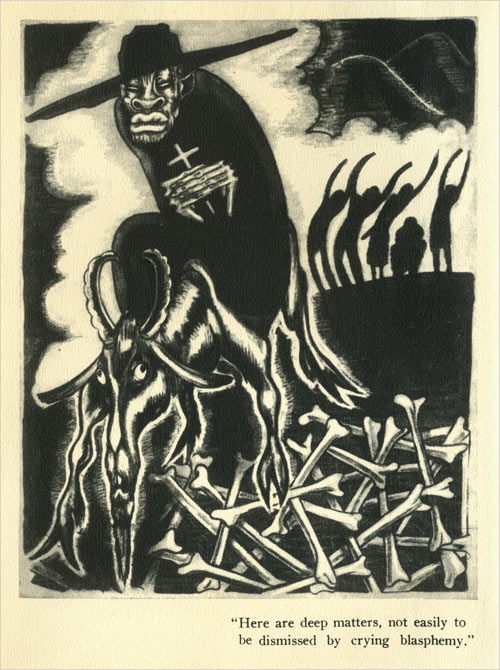

Quote: “Louis, son of Catherine Ozias of Orblanche, paternity unknown—and thus without a surname was he inscribed in the Haitian civil register—reminded me always of that proverb out of hell in which Blake said, “He whose face gives no light shall never become a star.” It was not because Louis’ black face, frequently perspiring, shone like patent leather; it glowed also with a mystic light that was not always heavenly. For Louis belonged to the chimeric company of saints, monsters, poets, and divine idiots. He used to get besotted drunk in a corner, and then would hold long converse with seraphim and demons, also from time to time with his dead grandmother who had been a sorceress.”

Quote: “The celebrants approached, processionally, singing, from the mystery house. At the head came the papaloi, an old man, blue-overalled, bare-footed, but with a surplice over his shoulders and a red turban on his head, waving before him the açon, a gourd-rattle wound round with snake-vertebrae. At his right and left, keeping pace with him, two young women held aloft, crossed above his head, two flags on which were serpentine and cabalistic symbols, sewn on with metallic, glittering beads. Behind him marched a young man bearing aloft, horizontally on his upstretched palms, a sword, and next the mamaloi, a woman in a scarlet robe and feathered headdress, who revolved as she progressed in a sort of dervish dance; next came marching, two and two, a chorus of twenty or more women robed in white, with white cloths wound bandana-wise on their heads, and as they slowly marched they chanted:
Damballa Oueddo,
Nous p’ vim
It would be best translated, I think, Oh, Serpent God, we come.”

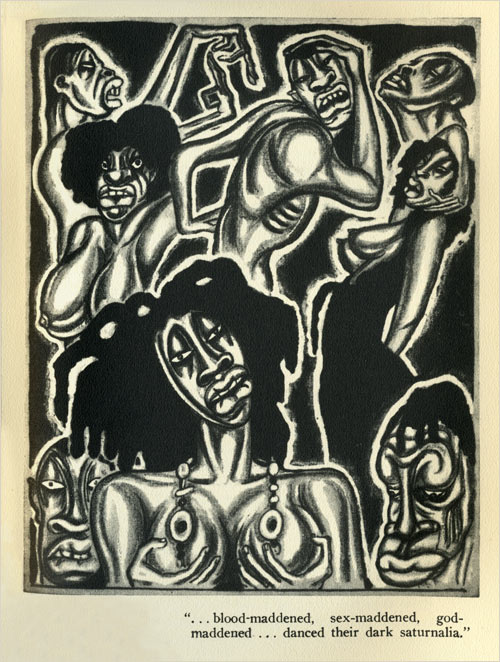
Quote: “In the red light of torches which made the moon turn pale, leaping, screaming, writhing black bodies, blood-maddened, sex-maddened, god-maddened, drunken, whirled and danced their dark saturnalia, heads thrown weirdly back as if their necks were broken, white teeth and eyeballs gleaming, while couples seizing one another from time to time fled from the circle, as if pursued by furies, into the forest to share and slake their ecstasy.”

Quote: “One of the most dreaded forms of Haitian-African magic includes the dressing of a corpse in a garment of the person marked for vengeance and then exposing it to rot away in some secret place in the jungle. Men have gone stark mad seeking that jungle-hidden horror, and others have died hopelessly, searching. Fear, hunger, thirst, jungle-terror, one may say. Names again, tags, labels. But marked for death by the Voodoo curse, they died.”

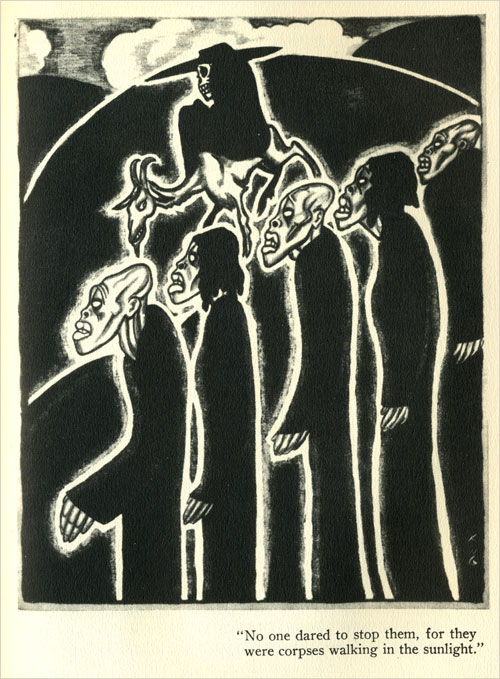
Quote: “It seemed that while the zombie came from the grave, it was neither a ghost, nor yet a person who had been raised like Lazarus from the dead. The zombie, they say, is a soulless human corpse, still dead, but taken from the grave and endowed by sorcery with a mechanical semblance of life—it is a dead body which is made to walk and act and move as if it were alive. People who have the power to do this go to a fresh grave, dig up the body before it has had time to rot, galvanize it into movement, and then make of it a servant or slave, occasionally for the commission of some crime, more often simply as a drudge around the habitation or the farm, setting it dull heavy tasks, and beating it like a dumb beast if it slackens.”
So while this text offers the first English language popularization of the word “zombie” those last 3 Illustrations, interestingly, represent the first images anyone associated the word. All in all fascinating bit of pop-cultural, if not exactly ethnographic or anthropological, history.
Jay A. Graybeal says in his terrific summation of Seabrook’s story: “Big lusty, restless, red-haired William Buehler Seabrook spent more than 20 years seeking fantastic adventure, then putting what he found into books which thrilled some, shocked many. But he never will write the story of his greatest adventure. Secretly and alone he embarked upon it not long ago by way of an overdose of sedative. The coroner says Bill Seabrook committed suicide. But his friends have a different explanation for what happened. They say he only was making another more drastic attempt to accomplish what he had tried, vainly, all his life to do—to get away from himself.”
Alester Crowley, an acquaintance of Seabrook’s, put it rather more bluntly in a diary entry: “The swine-dog W. B. Seabrook has killed himself at last.”
In 1966, a year after his death, a critic writing a review for a Seabrook biography said: “his principal literary contribution, it would seem, is the word zombie.” That may in fact be the truth. But how very impressive, built as it was on 12 short pages of reportage, that contribution turned out to be.
Zombie! Zombie!! Zombie!!!
Hope you enjoyed.
-
Related Linkage:
The Roots of the Modern Zombie Movie
Zombies in Popular Culture
Scifipedia: Zombies
The History of Zombies
Zombies in Early Horror Films
Voodoos and Obeahs
Gothic capitalism: The Horror of Accumulation and the Commodification of Humanity.
Black Religion and Black Magic: Prejudice and Projection in Images of African-derived Religions


Perverse, Subversive, and Absurd
Or: The Poster Art of Tomi Ungerer.
Tomi Ungerer’s work, along with that of a handful of others, might rightly be considered to not only embody the design style of the 60’s and 70’s, but to have played a central part in that style’s ascendence. Throughout those decades Mr. Ungerer’s work was everywhere, encompassing everything from politics and commercial concerns to erotic publications and children’s books. He was prolific, and in no realm more so than in that of the poster.
As it happens just yesterday I came across the perfect resource to illustrate that point, the 1971 book The Poster Art of Tomi Ungerer, compiled and edited by Jack Rennert. Below I’ve reproduced, for your viewing pleasure and Mr. Ungerer’s glorification, a small sampling of the terrific poster work contained therein. Have a look…


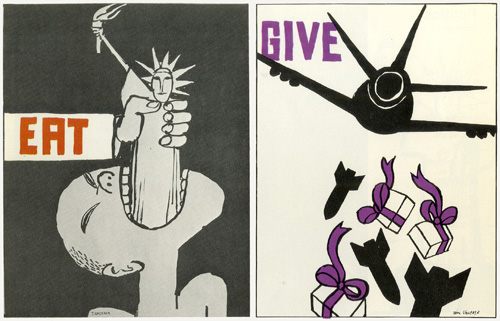


Quote: “Expect the unexpected” is a fitting description of all of Tomi’s posters. The element of surprise, the element of the absurd, is a clear constant in his posters. When Tomi is finished with a poster design, he will step back a bit, and if he’s really satisfied with what he’s done, he’ll say, “It’s absurd!”
This very absurdity, achieved by elements of surprise and exaggeration, makes for a good poster: one of the key elements of a good poster is that it be arresting, that it be immediately compelling. This propensity for gleefully combining the improbable with the absurd is carried through in all of Tomi’s works.” -Jack Rennert.
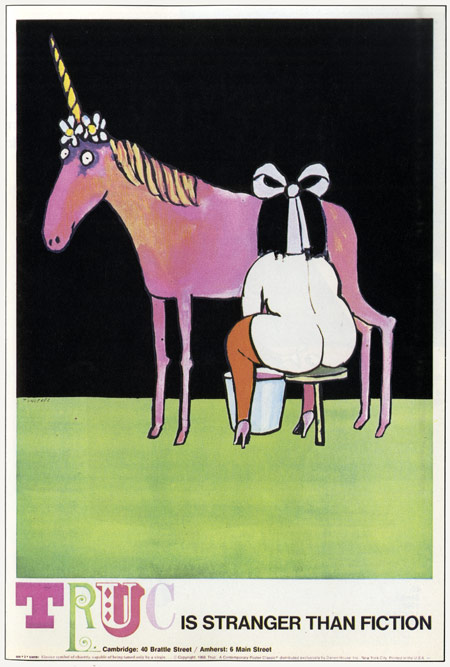
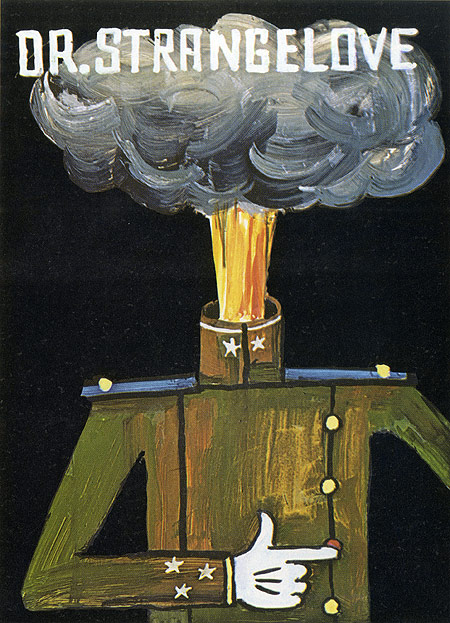




Quote: “Hans Pflug, writing about Tomi’s work when he first came to the United States, noted: ‘His drawings and advertisements all give the impression of having occurred to him in a flash, and of having been captured on paper with equal immediacy.’ To watch Tomi at work is to know that this was an accurate observation and is still so. What is amazing to me, is that Tomi at once gets a complete image of what he wants to do, and putting it down on paper becomes almost the automatic reflex of his clearly ‘seen’ image. He rarely goes back over his lines. They are immediately, cleanly, and finally, put down on paper. He may not be satisfied when he’s finished and will throw the whole thing out, but he’ll seldom redo or rework his lines or colors.” -Jack Rennert.





Quote: “The main influences in my work were, as a child, Mathias Grunewald, Durer, Schongauer, as well as Hansi and Schnugg, both Alsatian illustrators. Later came Goya, Bosch, the Japanese graphists (Hokusai, etc.), the old issues of Simplicissimus, and Wilhelm Busch.
My high school records were crowned with the final remark: ‘Perverse and subversive.’
My interest and hobbies vary and alternate: flying kites and balloons, old toys, books, bondage, erotica, minerology, botany, medicine, jazz-the list is vain and endless. My most meaningful author is Louis Ferdinand Celine, my favorite painter is Ingres, and Bach’s is just about the only music that gives me total satisfaction.” -Tomi Ungerer, from the introduction to The Poster Art of Toimi Ungerer





It was no easy task choosing what to include here but I hope you enjoyed these.
You can visit Tomi Ungerer’s homepage if you’d like to see some more of his work.
Also I’ve posted a small set of pieces Mr. Ungerer created for a 1966 IBM exhibition called Some Computer ABC’s over at the Nonist Annex.
Lastly, in that I was unable to find anything comparable on the web—the horse’s mouth and all that—I wanted to offer the full text of the biographical sketch Mr. Ungerer wrote for the introduction to the book. You can read it here.
hide full text




